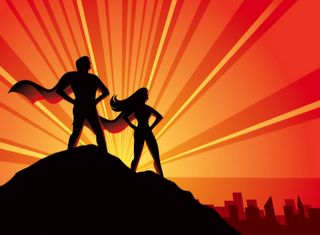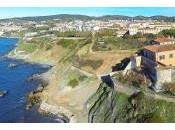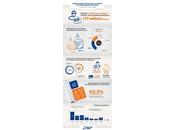Il successo di critica e di pubblico raccolto dal terzo capitolo della trilogia di Batman diretta da Christopher Nolan, la cui trama è ben raccontata da Fabio Chiusi, è stato da un certo punto di vista una grossa sorpresa, per chi si aspettava un riadattamento in funzione dei tempi.
 Sarebbe stato logico aspettarsi non più un giustiziere solitario ma un non-protagonista, un’espressione di una volontà collettiva, magari con un finale dove il supereroe in difficoltà viene aiutato da una collettività, proprio come nella scena finale di “V come vendetta” dove insorgono i cittadini, mascherati da Guy Fawkes.
Sarebbe stato logico aspettarsi non più un giustiziere solitario ma un non-protagonista, un’espressione di una volontà collettiva, magari con un finale dove il supereroe in difficoltà viene aiutato da una collettività, proprio come nella scena finale di “V come vendetta” dove insorgono i cittadini, mascherati da Guy Fawkes.
Alcune riflessioni sui recenti cambiamenti nella società (condizioni, abitudini, rischi) possono quindi aiutarci a capire se in tutto questo c’è dell’anacronismo.
I supereroi, miti creati dall’uomo fin dalla notte dei tempi e ripresi all’inizio del secolo scorso sotto forma di storie a fumetti, vennero ben presto utilizzati come elemento di propaganda antinazista durante la Seconda guerra Mondiale e anticomunista durante la guerra fredda. Lo stesso Magneto degli X-Men trascorse parte della sua infanzia ad Auschwitz.
In Italia, Superman dovette cambiare nome a favore dei più autarchici Ciclone, Uomo d'acciaio e Nembo Kid.
Il supereroe era più vicino al superuomo di Nietzsche, alle visioni emersoniane e alla Disobbedienza civile teorizzata da Henry David Thoreau. Oggi, più che un “uomo forte” sarebbe un uomo influente.
Chi è il supereroe? Il supereroe è una figura iconica che possiede abilità straordinarie che utilizza per combattere tutto ciò che mette in pericolo il territorio in cui vive e la sua popolazione (a volte, persino l’intera umanità).
Chi sono i supereroi al tempo dei social media? Li puoi riconoscere forse dall’elmetto giallo dei minatori della Carbosulcis, oppure puoi trovarli in mezzo agli operai dell’Alcoa. Sono sporchi, sudati, disperati e determinati, espressione di un territorio difficile: il Sulcis, moderne Termopili.
E i pompieri dell’attentato di undici anni fa a Ground Zero, sia quelli sopravvissuti che quelli rimasti sotto le macerie, ancora oggi ricordati per il loro comportamento eroico? Non sono forse supereroi anche loro? In fondo, Gotham City ricorda sinistramente New York, no?
Impossibile non pensare anche alle Paraolimpiadi appena concluse, dove un uomo di nome Alex Zanardi a 45 anni stravince due medaglie d’oro, una per ogni gamba che il destino gli ha portato via, ma risparmiandogli miracolosamente la vita dopo che in precedenza gli aveva offerto la notorietà come pilota di F1. Vittorioso con record alla maratona di New York, campione italiano di ciclismo su strada, campione nella vita, è stato insignito delle massime onorificenze a cui possono ambire cittadini e sportivi italiani. E’ sufficiente per essere considerato un supereroe?
Bradley Manning, due volte candidato al Nobel per la pace, ha finora trascorso 847 giorni di carcere durissimo senza nessuna incriminazione formale. Ha osato come nessuno prima di lui in nome della libertà d’informazione della quale è oggi il simbolo. Se non è un supereroe questo...
Che abilità deve possedere? Una volta il supereroe doveva possedere una forza sovrumana, saper volare, trasformare il proprio corpo in qualcosa di diverso, essere presente nel luogo e nel momento stesso in cui un evento grave avveniva. Oggi deve avere il coraggio di denunciare pubblicamente un sopruso, deve sapere comunicare attraverso qualsiasi medium, deve sapere coinvolgere e abilitare le folle, deve avere una rete di relazioni con persone che possono essere ovunque e in qualsiasi istante al posto suo.
Chi stabilisce chi è un supereroe? Supereroe si nasce o si diventa? Lo si diventa, inconsapevolmente: lo stesso Clark Kent aveva acquisito i superpoteri solo come reazione al cambiamento di atmosfera rispetto al pianeta Krypton. Una volta, però, era il supereroe stesso che si palesava alla società e si autoeleggeva tale quando scopriva di avere dei poteri particolari oppure spinto da giustizialismo. Agiva in difesa della massa, della quale però non gli interessava l’opinione perché agiva per soddisfare un proprio desiderio. Il supereroe era figlio delle storture della società, la stessa che ne aveva provocato la metamorfosi colpendolo profondamente e intimamente.
Oggi il supereroe è prima di tutto un leader riconosciuto come tale dalla massa e non potrebbe esistere senza questo appoggio. Attraverso i social media, chiunque può riuscire a ottenere grande visibilità e questo facilita il processo di creazione dei supereroi da parte della società. E’ un ruolo a tempo determinato, che cessa appena la massa comincia a credere che non sia più una figura credibile.
E’ rappresentativo? Una volta, il supereroe prendeva le distanze dalla società che lo ha partorito, andandovi a colmare una lacuna esistente sviluppando le qualità necessarie.
Oggi il supereroe è diretta espressione delle necessità delle folle, delle quali è interprete volontario o involontario.
E’ invincibile? Una volta, il supereroe era quasi invincibile, a causa di punti deboli (come la kryptonite per Superman) che però gli conferivano un tocco di umanità.
Oggi questo è indifferente, perché l’ecosistema in cui si muove segue modelli a rete ed è autoadattativo. Morto un supereroe, se ne fa subito un altro.
Che aspetto e identità ha? Bello come il sole e palestrato, compiva atti di eroismo esclusivamente indossando un costume che ne metteva in risalto la prestanza fisica. Il viso era coperto da una maschera per celare l’identità; Superman faceva eccezione, in quanto riusciva a non farsi identificare come Clark Kent nonostante si togliesse unicamente gli occhiali.
Oggi la maschera è quella di Anonymous e compare non solo per celare l’identità (ed evitare ritorsioni) ma anche quando si vuole negare l’identità personale in favore di una collettiva.
Dove vive? Una volta il supereroe viveva nelle grandi metropoli: caotiche, multietniche, piene di contraddizioni. Come New York. Oggi, con i social media che abbattono le barriere spaziali e temporali, potrebbe benissimo trovarsi nella periferia del mondo o vivere in un non-luogo.
Che simbolo usa? Il simbolo è fondamentale per affermarne l’identità. Oggi potrebbe essere un hash, un hashtag, un avatar, un glider o un like.
In che condizioni economiche vive? Il supereroe dei fumetti spesso è ricco e non ha bisogno di lavorare, così da avere molto tempo libero per combattere i nemici della società. Il supereroe di oggi se ha molto tempo libero è perché non ha un lavoro, ce l’ha saltuario o rischia di perderlo. Spesso proprio la motivazione economica è alla base delle sue azioni.
Chi sono i suoi nemici? I nemici classici del supereroe non erano generiche ingiustizie sociali ma singoli personaggi che alteravano gli equilibri della società. Al contrario, oggi sono la crisi economica internazionale, il tentativo di limitare la libertà di espressione sui media digitali, le dittature.
E’ amato oppure odiato? Oggi basta una frase fuori luogo per passare da salvatore della patria a persona da dileggiare, alla velocità di un tweet. La spontaneità paga, ma i rischi per la propria reputazione sono molti.
La differenza principale però è proprio che il supereroe classico agisce per riportare l'ordine e ristabilire equilibri consolidati. La sua opera è considerata infatti tranquillizzante.
Al contrario, il supereroe al tempo dei social media è destabilizzante, punta a sovvertire radicalmente e brutalmente gli ordini precostituiti, visti come inquinati dalle ingiustizie sociali. Per questo motivo è malvisto dall'establishment, ma può contare sull'apporto della base di persone nelle sue stesse condizioni. E' tutto sommato una figura positiva perché distrugge per ricostruire meglio. Fino al successivo inquinamento, quando tornerà per distruggere e ricostruire ancora.
Roberto Favini | @postoditacco
Superheroes in the times of social media
The critics and public success gained by the third chapter of the Batman trilogy, directed by Christopher Nolan, for which the story has been very well told by Fabio Chiusi, has been from some points of view a big surprise, at least for those who expected a re-adaptation according to times.
It would have been logical to expect not a solitary justice maker but a non-protagonist, an expression of collective will, eventually with a finale where the superhero in distress is helped by a multitude of people, much like in the final scene of "V for Vendetta", where citizens revolt dressed in Guy Fawkes outfits.
Some thoughts about the recent changes in society (conditions, habits, risks) can help us understand whether in all this there is any anachronism.
Superheroes, myths created by man since the beginning of time and turned into comic books at the beginning of the last century, have been utilized very soon as an antinazi tool of propaganda during WWII, and anticomunist during the Cold War. Even Magneto of the X-Men spent part of his childhood in Auschwitz.
In Italy, Superman had to change name in favor of Ciclone, The Steel Man and Nembo Kid.
The superhero was closer to Nietzsche's superhuman, to the Emersonian visions and the Civilian disobbedience theorized by Henry David Thoreau. Today, more than a "strong man", he would be an influential man.
Who is the superhero? The superhero is an iconic figure that has extraordinary abilities that he uses to fight everything that puts in danger the territory in which he lives and its population (sometimes, the entire humanity).
Who are superheroes in the times of social media? You can probably recognize them from their yellow helmet of the Carbosulcis miners, or you can find them among the Alcoa workers. They're dirty, sweaty, desperate and determined, expression of a difficult territory: the Sulcis, the modern Thermopilis.
And the firefighters of the attack eleven years ago at Ground Zero, both the ones who survived and the ones who remained under, who are still today remembered for their heroic behavior? Aren't they superheroes as well? After all, Gotham City is incredibly similar to New York, isn't it?
Impossible not to think about the ParaOlympic Games that have just finished, where a man called Alex Zanardi, at the age of 45 wins two gold medals, one for each leg that life took away from him, but miraculously giving him his life after offering him fame as a F1 pilot. Victorious with record at the New York marathon, Italian champion of cyclism, champion in his life, he has been given the highest honors that Italian citizens and athletes can hope for. Is it enough to be considered a superhero?
Bradley Manning, twice candidated for the Nobel Peace Prize, has been in jail for 847 days without any formal charges. He has dared as nobody before him, in name of that freedom of information of which he is the symbol today. If he's not a superhero...
What abilities does he have to have? Once, the superhero had to possess a superhuman force, he had to know how to fly, transform his body in something different, be present in the time and moment when something bad happened. Today he has to have the courage of publicly reporting an abuse, know how to comunicate through any medium, know how to involve and abilitate crowds, must have a web of relationships with people that can be anywhere and anytime in his place.
Who decides who a superhero is? Is a superhero born or does he become one? He becomes one, without even knowing: even Clark Kent had gained his superpowers as a reaction to the change of atmosphere in relationship with Krypton. Once, however, it was the superhero himself that presented himself to society and elected himself as one when he discovered he had powers, or when he was driven by justicialism. He acted in defense of the masses, and didn't care about its opinion because he acted to satisfy his own desire. The superhero was a child of society deformations, the same that had caused its metamorphosis by striking him hard and deep.
Today the superhero is first of all a recognized leader and couldn't exist without the support of the masses. Through social media, anyone can obtain great visibility, and this facilitates the process of creation of superheroes on behalf of society. It is a timed role, that ends the moment when the crowds decide that he is no longer a credible figure.
Is he representative? Once, the superhero took his distances from the society that had created him, and filling the existing gap by developing the necessary qualities. Today the superhero is a direct expression of the necessity of crowds, of which he is a voluntary or involuntary interpreter.
Is he invincible? Once, the superhero was almost invincible, because of his weak points (such as kryptonite for Superman) that gave him a touch of humanity. Today this doesn't matter, because the ecosystem in which he moves follows models in a web and is autoadaptive. When a superhero dies, another one is born.
What does he look like and what is his identity? Handsome as the sun and very fit, he did acts of heroism exclusively while wearing a costume that enhanced his physical shape. The face was covered by a mask to hide his identity: Superman was a an exception, since he managed to not get identified as Clark Kent, even though he only took off his glasses.
Today the mask is the Anonymous one and appears not only to conceal identity (and avoid revenges), but also when you want to deny a personal identity in favor of a collective one.
Where does he live? Once the superhero lived in great metropolis: chaotic, multiethnic, full of contradictions. Just like New York. Today, with social media destroying spatial and temporary barriers, he could just as well live in the perifery of the world or in a non-place.
What symbol does he use? The symbol is fundamental to affirm his identity. Today it might be an hash, a hashtag, an avatar, a glider or a like.
In what kind of economical conditions does he live? The comic book superhero is often rich and not in need to work, so he has a lot of spare time to dedicate to fighting the enemies of society. The superhero of today has a lot of spare time because he doesn't have a job, he has a saltuary one or he risks to lose it. Often it is the economical motivation that drives his actions.
Who are his enemies? The classical enemies of the superhero weren't generical social injustices, but single characters that altered the balances of society. On the contrary, today the dictatorships are the international economic crisis and the attempt of limiting the liberty of expression on digital media.
Is he loved or hated? Today one single wrong sentence can take you from savior of the country to despicable person, at the speed of a tweet. Spontaneity works, but the risks for reputation are many.
The main difference, though, is that the classical superhero acts to re-establish order and balances. His work is considered in fact quite tranquilizing.
On the contrary, the superhero at the times of social media is destabilizing, he aims at radically and brutally changing the preconstituted orders, seen as polluted by social injustices. For this reason he is not seen with favor by the establishment, but he can coun on the help of those people who are in his same situation. He is after all a positive figure because he destroys in order to build better. Until the next pollution, when he will come back to destroy and rebuild again.
Roberto Favini | @postoditacco







